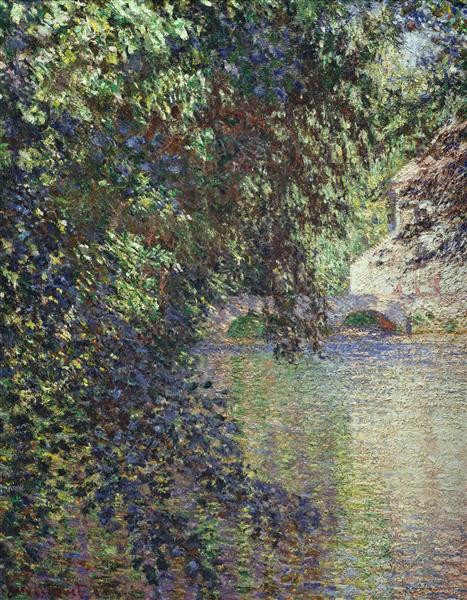Description
The painting “Watermill at Limetz,” created by Claude Monet in 1888, is a fascinating testament to the evolution of Impressionism and the artist’s mastery in depicting light and the natural environment. Capturing the serenity of a rural French landscape, this work features a watermill, a structure that evoked not only the daily life of its time but also a bridge to the connection between man and nature.
The composition of the work is notable for its balance and the way it directs the viewer's attention. The mill, located in the center-right of the painting, stands with a certain majesty, while the gentle undulations of the surrounding vegetation create a frame that envelops the structure without overshadowing it. The flowing water path in the foreground acts as a dynamic element, guiding the eye towards the background, where a richly nuanced landscape unfolds.
The use of colour is one of the most striking features of this work. Monet employs a palette of greens, blues and earthy tones that vibrate with an almost palpable freshness. The colour scheme not only reflects the various hues of the vegetation, but also suggests the interaction of light with surfaces, from the water to the leaves and the wood of the mill. The reflections in the water are particularly intriguing, capturing the essence of the environment and the atmosphere of the moment with loose, spontaneous brushstrokes that are emblematic of the Impressionist style.
Unlike many of Monet's works where humans are subtly depicted, there are no visible human figures in this painting. However, the absence of characters does not take away life from the scene; on the contrary, it allows the landscape to speak for itself. This choice suggests a deeper contemplation of nature and space, signaling Monet's intention to invite the viewer to lose themselves in the beauty of nature, away from human distractions.
The work was painted at a time when Monet was deeply involved in exploring the effects of light and atmosphere. "Watermill at Limetz" encapsulates a specific moment in time that invites quiet reflection. In this sense, it can be seen as part of a series of works that Monet produced during his stays in the area around the Seine, where he enjoyed an intimate connection with the landscape.
Furthermore, it is interesting to note that Limetz is a place that Monet painted on several occasions, being a beautiful natural setting on the outskirts of Paris that provided the artist with the opportunity to experiment with changing lights and the atmosphere of the region. “Water Mill at Limetz” is not just a depiction of a place, but a celebration of the beauty of the French rural landscape, captured through the lens of Impressionism.
In conclusion, “Watermill at Limetz” is a work that, despite its apparent simplicity, is rich in emotional and visual nuances. Claude Monet, through his skill in rendering light and form, offers us a vision of the harmony between man and nature, evoking a sense of peace and contemplation that resonates deeply with the viewer. This work thus fits into a rich tradition of Impressionism, reminding us of the power of painting to capture the transience of light and the beauty that surrounds us.
KUADROS ©, a famous painting on your wall.
Hand-made oil painting reproductions, with the quality of professional artists and the distinctive seal of KUADROS ©.
Painting reproduction service with satisfaction guarantee. If you are not completely satisfied with the replica of your painting, we will refund 100% of your money.

